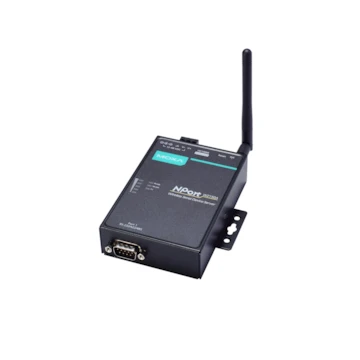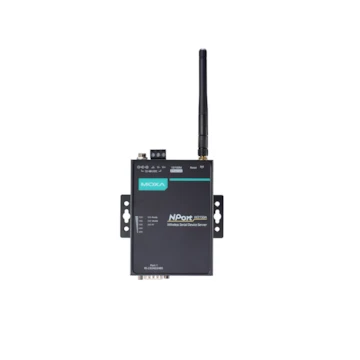Built-in WDT
RTC (real-time clock)
RP-SMA (male)
Omni-directional
Typ. -92 dBm @ 1 Mbps
Typ. -84 dBm @ 11 Mbps
Ad-hoc Mode, Infrastructure mode
2.412 to 2.462 GHz (11 channels)
5.180 to 5.240 GHz (4 channels)
5.260 to 5.320 GHz (4 channels)
DFS (Dynamic Frequency Selection) channel support: In AP mode, when a radar signal is detected, the device will automatically switch to another channel. However, according to regulations, after switching channels, a 60-second availability check period is required before starting the service.
5.500 to 5.700 GHz (11 channels)
DFS (Dynamic Frequency Selection) channel support: In AP mode, when a radar signal is detected, the device will automatically switch to another channel. However, according to regulations, after switching channels, a 60-second availability check period is required before starting the service.
5.745 to 5.825 GHz (5 channels)
Typ. -89 dBm @ 6.5 Mbps (20 MHz)
Typ. -71 dBm @ 72.2 Mbps (20 MHz)
Typ. -85 dBm @ 13.5 Mbps (40 MHz)
Typ. -67 dBm @ 150 Mbps (40 MHz)
Up to 100 meters (in open areas)
2.412 to 2.484 GHz (14 channels)
5.180 to 5.240 GHz (4 channels)
5.260 to 5.320 GHz (4 channels)
DFS (Dynamic Frequency Selection) channel support: In AP mode, when a radar signal is detected, the device will automatically switch to another channel. However, according to regulations, after switching channels, a 60-second availability check period is required before starting the service.
5.500 to 5.700 GHz (11 channels)
DFS (Dynamic Frequency Selection) channel support: In AP mode, when a radar signal is detected, the device will automatically switch to another channel. However, according to regulations, after switching channels, a 60-second availability check period is required before starting the service.
Typ. -91 dBm @ 6 Mbps
Typ. -73 dBm @ 54 Mbps
DSSS
OFDM
802.11a/g: 54 Mbps
802.11b: 11 Mbps
802.11n: 6.5 to 150 Mbps
2.412 to 2.472 GHz (13 channels)
5.180 to 5.240 GHz (4 channels)
5.260 to 5.320 GHz (4 channels)
DFS (Dynamic Frequency Selection) channel support: In AP mode, when a radar signal is detected, the device will automatically switch to another channel. However, according to regulations, after switching channels, a 60-second availability check period is required before starting the service.
5.500 to 5.700 GHz (11 channels)
DFS (Dynamic Frequency Selection) channel support: In AP mode, when a radar signal is detected, the device will automatically switch to another channel. However, according to regulations, after switching channels, a 60-second availability check period is required before starting the service.
802.11a/b/g/n
16±1.5 dBm @ 1 Mbps
16±1.5 dBm @ 11 Mbps
Typ. -89 dBm @ 6.5 Mbps (20 MHz)
Typ. -71 dBm @ 72.2 Mbps (20 MHz)
2.412 to 2.472 GHz (13 channels)
5.180 to 5.240 GHz (4 channels)
5.260 to 5.320 GHz (4 channels)
DFS (Dynamic Frequency Selection) channel support: In AP mode, when a radar signal is detected, the device will automatically switch to another channel. However, according to regulations, after switching channels, a 60-second availability check period is required before starting the service.
5.745 to 5.825 GHz (5 channels)
16±1.5 dBm @ 6 Mbps
14±1.5 dBm @ 54 Mbps
15 dBm @ 1.5 Mbps (6.5 MHz)
12 dBm @ 1.5 Mbps (150 MHz)
Typ. -91 @ 6 Mbps
Typ. -74 @ 54 Mbps
WEP encryption (64-bit and 128-bit)
WPA/WPA2-Enterprise (IEEE 802.1X/RADIUS, TKIP, AES)
WPA/WPA2-Personal
15±1.5 dBm @ 6 Mbps
14±1.5 dBm @ 54 Mbps
16 dBm @ 1.5 Mbps (6.5 MHz)
12 dBm @ 1.5 Mbps (72.2 MHz)
1 x RS-232/422/485
Links serial and Ethernet devices to an IEEE 802.11a/b/g/n network
Web-based configuration using built-in Ethernet or WLAN
Enhanced surge protection for serial, LAN, and power
Remote configuration with HTTPS, SSH
Secure data access with WEP, WPA, WPA2
Fast roaming for quick automatic switching between access points
Offline port buffering and serial data log
Dual power inputs (1 screw-type power jack, 1 terminal block)








.jpg)



